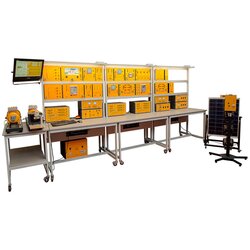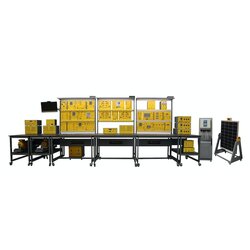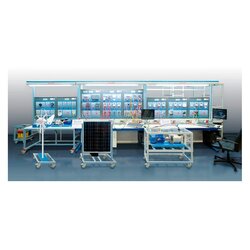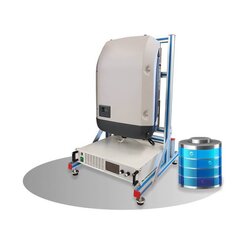Smart Grid Enhanced With Artificial Intelligence (DL SGWD-AI)
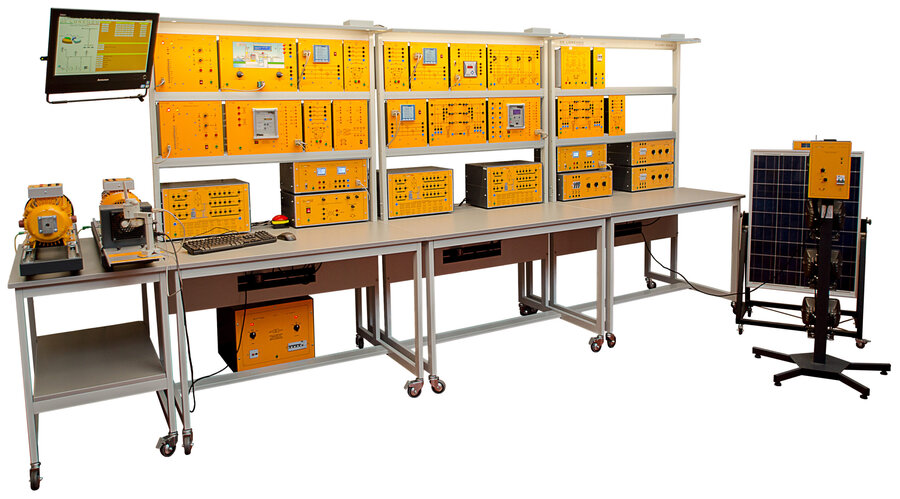

PL-591151
WHY A SMART GRID ENHANCED WITH AI?
Since the early 21st century, opportunities to take advantage of improvements in electronic communication technology to resolve the limitations and costs of the electrical grid have become apparent.
Technological limitations on metering no longer force peak power prices to be averaged out and passed on to all consumers equally. In parallel, growing concerns over environmental damage from fossil fuel-fired power stations have led to a desire to use large amounts of renewable energy.
Dominant forms such as wind power and solar power are highly variable, and so the need for more sophisticated control systems became apparent, to facilitate the connection of sources to the otherwise highly controllable grid. Power from photovoltaic cells (and to a lesser extent wind turbines) has also, significantly, called into question the imperative for large, centralized power stations. The rapidly falling costs point to a major change from the centralized grid topology to one that is highly distributed, with power being both generated and consumed right at the limits of the grid. Growing concern over terrorist attack in some countries has led to calls for a more robust energy grid that is less dependent on centralized power stations that were perceived to be potential attack targets. The integration of Artificial Intelligence (AI) module, such as DL AI-MODULE, plays a crucial role. Advanced AI algorithms can analyze vast amounts of data from distributed energy resources, optimizing energy production and consumption in real-time. By predicting demand patterns and integrating renewable sources effectively, AI can enhance grid stability and reduce reliance on fossil fuels. Furthermore, AI can facilitate proactive maintenance and fault detection, minimizing downtime and ensuring a more resilient energy infrastructure. It will enable personalized energy management solutions for consumers, promoting energy efficiency of the power system.
WHAT IS A SMART GRID?
The Smart Grid is a system for an "intelligent distribution" of electricity, able to know the consumption of the various end users and to manage the generation and distribution of electricity according to demand. Simply put, if in each area we have a potential overload of energy, the excess energy can be redistributed to other areas that need it, based on the actual requests from end users. Furthermore, the software that runs the Smart Grid monitors the electrical flow of the system, integrates renewable energy into the network and activates/suspends the industrial or domestic processes during periods when electricity costs less/more. The smart grid knows our requirement of power consumption. When the demand for electricity is at its maximum, the smart grid automatically adapts to the demand by picking up excess energy from many sources to avoid overload problems or interruptions of power. It has, therefore, the function of sharing electricity that is generated from various sources, both public and private, traditional and renewable, and ensures that electrical devices use electricity as efficiently as possible.
OPEN SCADA-WEB
The full system is integrated by an industrial Supervision and Control Data Acquisition (SCADA) software that communicates with all the active devices in the trainer and performs the following actions:
- Acquisition and measurements of the physical quantities of the system;
- Control of the system’s operation;
- Visual supervision of the system (also in remote mode), using synoptic diagrams: operational status, alarms, etc.
Through the SCADA software, the operator can monitor the electric flow in the system to manage and optimize the power requirements based on the consumption, through the acquisition of real-time data from the measuring devices and protection relays and the control of actuators for an “intelligent” management of the whole electrical system.
The different sections of the trainer communicate through dedicated serial RS485 buses using standard industrial communication protocols such as MODBUS RTU.
The SCADA project is divided into templates each one corresponding to a particular exercise. The open SCADA-WEB developers license provided with the trainer allows the teachers to fully customize the existing templates or create new ones that can be used to monitor the system from a local workstation.
SCADA main features
The software is structured following a didactic approach, dividing each study unit into single exercises.
The open SCADA-WEB license gives the teachers the possibility to create their own projects and fully customize the experiments by displaying the parameters of interest and controlling the actuators for an “intelligent” power management.
DE LORENZO’s SOLUTION
The smart grid system developed by De Lorenzo can be organized in eight subsystems, each comprised of several modules. The first four subsystems are simulations of energy sources; the first one is the main power supply of the grid with a three-phase supply unit that represents a coal plant.
The other three subsystems correspond to alternative sources of energy: wind, hydroelectric and solar. The wind plant simulation is made with a three-phase induction motor acting as a generator while the hydroelectric plant simulation is made with a three-phase synchronous machine, additionally with a generator synchronizing relay module to make possible the connection to the grid. Finally, the solar energy part of the system is generated with a solar panel and twelve dimmable lamps simulating the sun, which is connected to an inverter module that allows the energy generated to be transferred to the grid.
A fifth subsystem in the smart grid consists of modules for fault protection; the modules are a feeder manager relay that measures in real time voltages and currents to detect faults in the grid and four power circuit breakers controlled by the previous module to disconnect faulty lines.
The sixth subsystem refers to modules for measuring; it has three maximum demand meters that measure AC voltages, currents, frequencies, active power, reactive power, apparent power, power factor and THD for each of the three available phases in the grid and two electrical power digital measuring units that, besides measuring the same as the previous module, make measurements of DC voltage, current, power and energy.
The seventh subsystem is for power factor control with 2 modules, the first one is a switchable capacitor battery with four different values of capacitors and the second one is a reactive power controller that activates the capacitors of the previous module to make a power factor correction.
The last subsystem is composed of passive elements; three modules with different kind of loads (capacitive, inductive, resistive) that simulate the loads in a house or factory and two modules with impedances simulating the losses generated in transmission lines, specifically in lines of 10 and 100 km length.
A SCADA software provides to the acquisition and storage of the data coming from the measurement instruments and to the control of the actuators for an “intelligent” management of the whole electrical system. The SCADA software can also be supplied on request in an OPEN version, so that the teacher can implement his own project and select modes and procedure for visualizing the parameters and controlling the actuators. Artificial Intelligence plays a crucial role, it influences various techniques to enhance the efficiency and reliability of the electrical grid. By applying supervised learning, reinforcement learning, and anomaly detection, these experiments optimize energy consumption, predict renewable energy generation, and improve grid stability. AI enables fault detection, proactive maintenance, and intelligent load control, reducing downtime and enhancing resilience. At the end of the Experiments section, you will find detailed descriptions of each experiment, including their AI area and machine learning category. The system described above represents the basic configuration of our laboratory (DL SGWD-AI).
Optionally, it is also possible to add an additional wind energy small scale generation system, with a real wind turbine connected to an inverter module to make the connection to the grid (DL SGWD-W-AI).
TRAINING OBJECTIVES The Smart Grid trainer can be considered a multidisciplinary laboratory, it allows studying and exercising different technical subjects, that are then integrated into a full Smart Grid system setup.
The Smart Grid trainer is an integrated laboratory that can be useful for a huge number of undergraduate and graduate courses in the engineering school. The laboratory equipment can be configured to create different exercises, which reinforce basic and advanced concepts in electric energy. The equipment can be interconnected to form a full smart grid system. However, as you can see from the list of experiments in the next paragraph, conventional topics, such as electric machines, distribution systems and so on, could be covered by the Smart Grid trainer; this innovative laboratory can include class demonstrations and laboratory experiments under regular laboratory classes.
There are fundamental topics that are needed for understanding the smart grid concept and they must relate to real life situations, yet a set of different topics could be added to get a special curriculum. The core topics include electric circuits, electric machinery, hydroelectricity, wind energy, photovoltaic solar energy, renewable energies, power transmission, power distribution.
Furthermore, additional courses can benefit from the smart grid trainer, such as, for example: power system engineering & analysis, electric machines, linear control systems, electrical distribution engineering and smart grids automation, power generation operation and control, power electronics, cost and construction of electrical supply, power system stability, optimization methods, stochastic processes, embedded systems.
The smart grid system can be used by mechanical and electrical engineering students as a longtime project as it comprises enough elements to cover most of the topics listed above.
Electric circuits’ particular subjects can be studied through load modules, enabling the full understanding of resistive, capacitive and inductive loads, fed by AC or DC supply. Protected equipment permits the application of domestic and industrial rated electric magnitudes as well as their instrumentation. Effects of inductive loads and power factor correction are issues which can also be addressed.
The study of AC electric machinery can also be complemented with the practical insight provided by the induction and synchronous generators used to emulate a wind and a hydro-electrical power plant respectively.
Synchronization methods, power and instrumentation transformers, and the inner physical phenomena can be measured and studied as individual elements or as part of the whole power distribution system.
The entire system can be tested under many considerations as it is configurable, so different experiments can be driven based on the same principles. When analyzing distribution systems and fault schemes, the instrumentation and logical equipment can provide enough flexibility to understand the process between power generation and usage, together with abnormal events and their respective protective relaying issues. In this way, the topics added in the curricula which regard power management and distribution can also find room in the integrated smart grid project, which can be also evaluated under efficiency concerns depending on load conditions or generators’ states.
In this way, the smart grid as a set of individual modules or, enables the student to move towards a single objective necessarily going through each individual area, making possible the full understanding of smart grid theory, application, and capabilities, as well as the concerning steps of its integration.
The Smart Grid trainer also allows us to understand advanced topics like energy production in wind plants that are connected to the main electric grid, or they can be isolated as micro-grids, so the students can comprehend real problems in engineering which are imperative in the energy progress; thus, the basic and advanced courses can be combined in the wind turbine system. For example, wind generators include a pitch controller that increases energy efficiency, and the energy generated is sent to the central electric grid; hence, the students must use several topics such as control systems, digital control, electric machines, and so on.
As an additional example, a combination of 3 energy sources can be studied when they are providing energy to the load. If the conventional source is combined with wind and hydro energy, the student will be able to understand in a clear manner the process of providing energy to the load by alternative energy. Moreover, environmental questions can be included in the exercise (carbon footprint).
The number of exercises and topics can be expanded, and the student is able to propose novel ideas about how to solve problems that affect society; hence, the motivation of student can be increased.
In conclusion, engineering courses need to cover experimental concepts that increase the engineering knowledge of students, but it is not easy to find experimental systems that allow them to combine those concepts.
Although Smart Grid is a quite complex problem that is impacting electrical energy, it could be used for leaning basic concepts like electric circuits; hence, this system includes all the elements for providing real experience in the mechanical and electrical engineering curricula and impact the advanced and basic topics in the curricula. Smart Grid is a perfect system for teaching and involving students in experimental engineering problems. Besides, the student can deal with ecological and economic problems. The experimental use of solar and wind energy provides information about how the alternative sources of electrical energy can be used in large and low scale.
Our proposal includes exercises with Smart Grid on different topics; thus, this system is the conductor for connecting theoretical and practical concepts.
LIST OF EXPERIMENTS
HYDROELECTRICAL SYSTEM
Brushless
Generator no load characteristic Generator load characteristic Regulation performances characteristics Automatic synchronization
Overcurrent protection
Over-voltage or under-voltage protection
Over-frequency or under-frequency protection
WIND SYSTEM
Relation between a pitch control system and wind
Analysis of the mechanical parameters within an induction generator Analysis of electrical parameters within an induction generator
PHOTOVOLTAIC SYSTEM
Characterization of a photovoltaic panel without a load Characterization of a photovoltaic panel with a load
Connecting a photovoltaic system to the real network by using an inverter grid system mono phase.
TRANSFORMER
Vector group
No load performance Load performance
Asymmetrical performance Regulation performance
TRANSMISSION
No-load performances Matched-load performances Ohmic-inductive load
Ohmic-capacitive load Automatic compensator Transmission line radial network
Transmission line meshed network Transmission line: fault-to-earth and protection Transmission line: earth fault protection Transmission line:
under voltage protection Transmission line: over voltage protection
SMART GRID
SMART GRID
Contribution of solar energy Contribution of hydropower Contribution of wind plant
SMART GRID ENHANCED WITH ARTIFICIAL INTELLIGENCE
Energy Consumption Prediction
Fault Detection in the Grid
Optimization of Renewable Energy Usage
Power System Stability Analysis
Intelligent Load Control
Wind Power Generation Prediction
Solar Power Generation Prediction
Transformer Anomaly Detection
Power Quality Classification
AI-Based Microgrid Simulation
SMART GRID ENHANCED WITH AI
AI is revolutionizing the energy sector by improving efficiency, reliability, and sustainability. This study presents a series of AI-driven experiments focused on key challenges, such as energy consumption prediction, fault detection, renewable energy optimization, and grid stability. Using advanced techniques including supervised learning, reinforcement learning, and anomaly detection. Below, you will find the full descriptions of each experiment, along with their AI area and ML category.
MANUALS
The system includes an experiment manual with a detailed description of all the experiments that we suggest for the system.
Furthermore, the system is supplied complete with a book of approximately 300 pages “EXPERIMENTAL CONCEPTS OF SMART GRID TECHNOLOGY BASED ON DELORENZO SMART GRID”, written by Dr. Pedro Ponce and Dr. Arturo Molina, from the Tecnológico de Monterrey (Mexico).
SAMPLE EXERCISE
CONTRIBUTION OF SOLAR ENERGY
Assume that there is demand for energy from a distant point and there is solar energy to be able to be exploited. In this exercise, the student will intervene by reducing the consumption of energy from a plant of old generation, using the surplus energy produced by solar photovoltaic systems.
The reduction of even a minimum of energy absorbed will certainly have an impact on the environmental pollution produced by a plant of the old generation.
- Set the load DL 1017R to position 2 and close the relay R2 to supply energy coming from the coal plant.
- Close the relay R4 to transfer energy coming from the plant to the load and observe the power consumption on the module DL 2109T29. In this situation you can see the active power required from the resistive load (DL 1017R) and a few of reactive power required from the primary of the step down transformer.
- Observe the active power consumption indicated by the red arrow after the step-down secondary transformer. In this situation, the total energy coming from the coal plant and directed to the load, crossing the long distance, produces a power loss in the transmission line.
- Increment the sun energy and check the contribution of energy coming from the photovoltaic system plant. (with light at 100% and panel in 90°)
The active power coming from the coal plant is going to be reduced and as well then, the reduction of pollution in terms of CO2. If you convert the reduction of power into a pollution on a large scale, we can make a big contribution to environment. The reduction of the energy is less if you use artificial lights, but if you orient the photovoltaic panel to the real sun the contribution would be higher.
DL SGWD-AI - LIST OF MODULES
DL 2108T26 Brushless Controller with Motor
DL 1021/4 Squirrel cage three phase asynchronous motor
DL 1013A Base
DL 1026P4 Three-Phase Synchronous Machine
DL 1017R Resistive Load
DL 1017L Inductive Load
DL 1017C Capacitive Load
DL 2108TAL‐CP Three Phase Supply Unit
DL 1067S Motor Driven Power Supply
DL 7901TT Overhead Line Model – 360 Km
DL 7901TTS Overhead Line Model – 110 Km
DL 10065N Electrical Power Digital Measuring Unit
DL 2109T29 Three‐Phase Power Meter
DL 2108T25 Generator Synchronizing Relay
DL 2108T23 Feeder Manager Relay
DL 2108T02 Power Circuit Breaker
DL 2108T02A Power Circuit Breaker
DL 2108T19 Reactive Power Controller
DL 2108T20 Switchable Capacitor Battery
DL 9031 Circuit Breaker
DL 9013G Inverter Grid
PFS-85 Photovoltaic Solar Panel
DL SIMSUN Lamps For the Photovoltaic Solar Panel
DL WINDSIM Wind Simulator
DL HUBRS485F Modbus Communication Hub
DL SCADA3+ Software Scada
DL AI-MODULE Artificial intelligence module
DL 1080TT Three‐Phase Transformer
DL 1155SGWD Kit Of Connecting Leads
DL T12090 120x90 Working Bench
DL T06090 60x90 Working Bench
DL A120-3M-LED Frame
DL PCGRID All-In-One Personal Computer
DL 2100TTI Three-Phase Transformer
DL 1196 Holder For Leads
OPTIONS:
- Microgrid wind energy - It allows adding a microgrid wind energy system in parallel to the photovoltaic solar system at the user end of the system – ordering code: DL SGWD-W-AI
- A micro-grid wind turbine powered by a servo-motor simulating the action of the wind.
- A single phase grid-tie inverter that feeds power from the turbine into the mains
- Dedicated instrument provide the information needed for the characterization of the wind system.
Additional modules for DL SGWD-AI-W, with Microgrid wind plant
DL T12090_SK Multipurpose table (120x90x80cm) basic version with Shuko socket
DL A120-3M-LED Frame with 3 levels version with led lamps
DL 9030 Energy measurement module
DL 9032 Network distributor module
DL WTS-CTRL750 Control module for brushless motor 750W
ANEMOMETER Anemometer module
DL WTS-3 Wind Turbine Simulator
DL 9017 Lamps module
DL 9013G3D Inverter grid module 300W IN 3ph. 12Vac with braking resistance
DL 9027 Measurement module for wind generator
DL 9031 Circuit Breaker
What is this?
These percentage scores are an average of 0 user reviews. To get more into detail, see each review and comments as per below
If you have used this product, support the community by submitting your review
